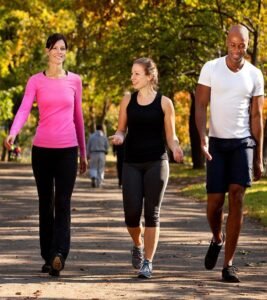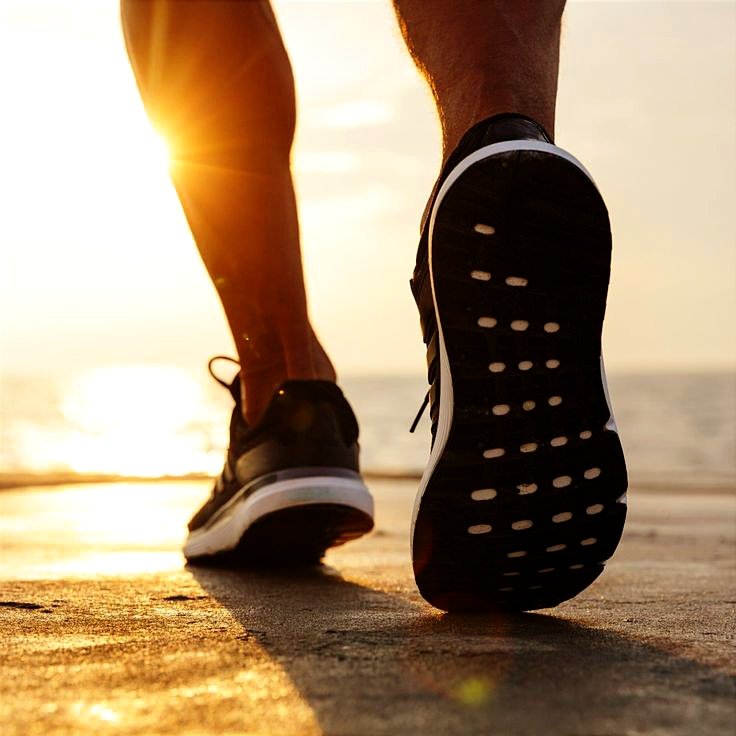Benefits of Morning Walk
Benefits of Morning Walk

One of the simplest and most effective ways to improve your overall health and well-being is by incorporating a morning walk into your daily routine. Walking is a low-impact exercise that can be enjoyed by people of all ages and fitness levels. Whether you prefer a brisk walk or a leisurely stroll, there are numerous benefits to starting your day with a walk.
What makes taking a morning walk necessary?
If it’s sunny when you go for a morning walk, you’ll get enough of vitamin D.
This will make up for the body’s vitamin D shortage.
You will receive enough of oxygen if you walk every morning.
Because plants generate carbon dioxide at night, there is less oxygen available in the dark.
In addition to calcium, vitamin D is essential for strong bones; if the body receives enough of it, calcium can be utilized effectively.
Beneficial for reducing stress :
All the advantages of a morning walk aid to lessen sadness since walking in the early morning sun is particularly beneficial, if necessary, for those who are experiencing mental stress. In addition, walking in the cool summer months helps prevent diabetes, high blood pressure, heart disease, and mental stress if you have the disease.
Why take a morning walk?

The air is cleaner in the morning, the ambiance is peaceful and energizing, and the body receives some activity. It’s crucial to avoid talking to each other just when strolling, since this can enhance immunity and oxygen levels, which in turn can increase lung capacity.
Morning walk has several general health benefits, including:

- glowing skin
- heart health
- diabetes control
- aiding in weight loss
- Improves brain function
- Improves sleep
- Boosts immunity
- Lowers cholesterol
- Beneficial for those with cancer
- Improves brain function
- Boosts immunity
- Boosts cardiac output
- Gets rid of weariness
- Energizes the body
- Assists in lowering cholesterol
- Assists in lowering fat deposits
- Every kind
Walk is helpful in preventing illness.
You should walk for 45 to 90 minutes every morning at the absolute least to maintain your general physical fitness.

1) One pair of sports shoes
2) Shorts or leggings
3) A short T-shirt
4) A sports bra hair band for women
5) A sports water bottle are necessities when beginning to walk
6) Your enthusiasm
Take a walk for wellness

You’ll be amazed to learn about these advantages of walking!
Many claim that walking has numerous advantages. Even though walking has several advantages, a lot of people choose not to do it. Nonetheless, walking has become extremely important in today’s world.
Walking quickly has been shown in a recent study to be beneficial in treating depression. Walking quickly lowers the chance of being admitted to the hospital and length of stay.
Compared to slow walkers, fast walkers had a 37% lower chance of hospital admission after three years.
Seniors tend to prefer walking more than driving. Young people ought to benefit from this as well. There is no cost associated with this workout, and no prior training is required.
Advantages of Fast Walking
- A half-hour walk every week lowers the risk of stroke by thirty percent.
- Walking every day for 30 to 60 minutes lowers the chance of having a heart attack.
- Everyday walks of 30 to 40 minutes lower the risk of diabetes by 29%.
- A half-hour walk each day lowers the chance of developing depression by 36%.
- Walking decreases obesity when done for at least an hour each day.
- Taking a morning stroll provides the body with fresh oxygen derived from the morning air.
- Morning sunshine provides vitamin D, which is necessary for strong bones.
- Walking is an excellent form of both mental and physical exercise.
- Walking helps to relieve the physical and mental tiredness caused on by long work.
- Walking reduces tension and agitation
- Sleep is also enhanced by walking.
- Walking is also helpful for meditation and focus.
- Walking burns extra calories in the body*14) Walking lowers body fat *15) Walking is the finest form of exercise if you want to lose weight.
- Studies have shown that walking for an hour a day helps lessen the discomfort associated with arthritis.
- Walking helps with digestion and lessens constipation and other digestive issues.
- Walking quickly raises heart rate.
- People who frequently exercise have a death rate from heart disease that is less than 50%.
- Frequent walking enhances lung health.
- Frequent walking helps manage breathing issues, high blood pressure, diabetes, heart disease, and back pain.
- Walking frequently increases metabolism. enhances the activity of endocrine glands.
- Walking also helps to strengthen bones.
- Consistent walking tones leg, thigh, and waist muscles.
- Lowers the chance of cataract development.
- Frequent walking helps shield against several cancers.
- Regular walking has the potential to fortify the immune system (*27).
- Walking has been shown to help reduce depression
- A daily walk of thirty minutes lengthens life expectancy on average by three years.
- The secret to longevity is regular walking.
The easy solutions listed below can be useful before visiting the doctor, especially for senior persons.

1. food stuck in the throat
“Raise your hand” is all that is required.
The food lodged in your throat will go down if you extend your arms straight above your head.
2. cramping in the legs
When your left leg cramps, raise your right arm; conversely, when your right leg cramps, elevate your left arm. You’ll feel better right away.
3. Neck discomfort
There are moments when we experience neck ache as we wake up. Using the incorrect pillow could be one of the causes of this. Simply elevating your feet, pulling your toe, and rotating your feet clockwise or counterclockwise can provide comfort in these situations.
4. Foot tingling
Use all of your effort to circle your right arm when your left leg starts to tingle. Use all of your effort to circle your left arm when your right leg starts to tingle. It will start to gain right away.
Another dimension is walking.
To say that your calf muscles are your “second heart” is a true statement.
Everyone is aware of the heart’s purpose.
The body’s pump is the heart. This pump prevents blood from pooling in one area and maintains it flowing through the arteries and veins throughout the body.
However, the body is also using another pump. Indeed, it is.
The muscles in your abdomen serve as your second heart.
The heart’s function is to maintain blood flow via the system of vessels. We refer to this as blood circulation.
Maintaining the blood’s constant flow is critical. Blood clots may form and become lethal if this is not the case and the blood stays in one location instead of being distributed throughout the body’s organs. The heart is assisted by the leg muscles in maintaining blood circulation throughout the body. The pelvic muscles contract when we walk or run, pushing blood from the muscles’ blood arteries toward the heart. Our bodies are made that way by nature.
The foot pods’ blue blood veins serve as a blood reserve.
The term “muscular venous sinuses” refers to them.
Blood deposited in the legs is forced upward via the veins and toward the heart as the leg muscles contract. These legs’ blood arteries have a unique kind of valve. The flow of blood is directed by these valves. Blood can pass via these valves from the heart to the legs, but not the other way around. The force of gravity causes blood to naturally want to flow downward when you are standing. These valves push blood back towards the heart to stop it from collecting in the legs as a result of gravity. The contraction of the abdominal muscles during walking or running assists the heart in pumping blood.
The leg just below the ankle also stores a certain volume of blood.
When we walk, the blood is initially pushed up towards the heart by the soles’ contractions, and then all of the blood is pushed farther against gravity and into the heart by the pelvic muscles’ contractions.
Blood arteries have valves that stop blood flow downward. The pelvic muscles are unable to contract if we remain motionless for extended periods of time, such as hours spent in a chair, automobile, or aircraft. Blood clots (DVT, deep vein thrombosis) are more likely to occur when there is an accumulation of blood in the legs. We therefore understand how important it is to run and walk.
Long times of bed rest might cause deep vein thrombosis (DVT).
This indicates clots of blood in his leg veins. This results in swelling and soreness in the foot soles. These blood clots have the potential to be fatal if they escape from the legs and become lodged in the lungs.
Leg pain may also result from any injury done to the pelvic valves. In the legs, blood builds up when the valves are injured. There may be symptoms such as leg weight, exhaustion, numbness, swelling in the ankles, enlarged leg veins, sharp leg pains, skin discoloration, non-healing foot wounds, etc.
Simply put, keep walking and, if you can, run.
Remain robust and well.
Take a stroll for your health.
You won’t get the morning benefits if you exercise every morning.
You will get numerous health benefits if you walk at the appropriate time and in the appropriate manner.
Yes, there are numerous advantages to starting your walk in the morning between six and seven in the morning when the sun is shining.




